FIAT FIORINO 2019 Owner handbook (in English)
Manufacturer: FIAT, Model Year: 2019, Model line: FIORINO, Model: FIAT FIORINO 2019Pages: 220, PDF Size: 6.22 MB
Page 31 of 220
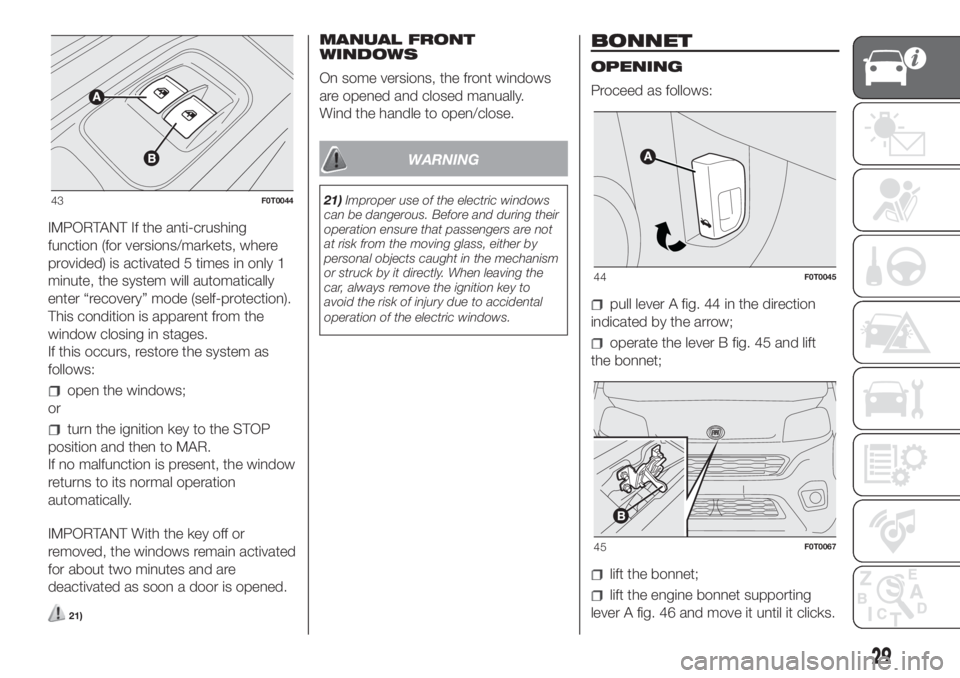
IMPORTANT If the anti-crushing
function (for versions/markets, where
provided) is activated 5 times in only 1
minute, the system will automatically
enter “recovery” mode (self-protection).
This condition is apparent from the
window closing in stages.
If this occurs, restore the system as
follows:
open the windows;
or
turn the ignition key to the STOP
position and then to MAR.
If no malfunction is present, the window
returns to its normal operation
automatically.
IMPORTANT With the key off or
removed, the windows remain activated
for about two minutes and are
deactivated as soon a door is opened.
21)
MANUAL FRONT
WINDOWS
On some versions, the front windows
are opened and closed manually.
Wind the handle to open/close.
WARNING
21)Improper use of the electric windows
can be dangerous. Before and during their
operation ensure that passengers are not
at risk from the moving glass, either by
personal objects caught in the mechanism
or struck by it directly. When leaving the
car, always remove the ignition key to
avoid the risk of injury due to accidental
operation of the electric windows.
BONNET
OPENING
Proceed as follows:
pull lever A fig. 44 in the direction
indicated by the arrow;
operate the lever B fig. 45 and lift
the bonnet;
lift the bonnet;
lift the engine bonnet supporting
lever A fig. 46 and move it until it clicks.
43F0T0044
44F0T0045
45F0T0067
29
Page 32 of 220
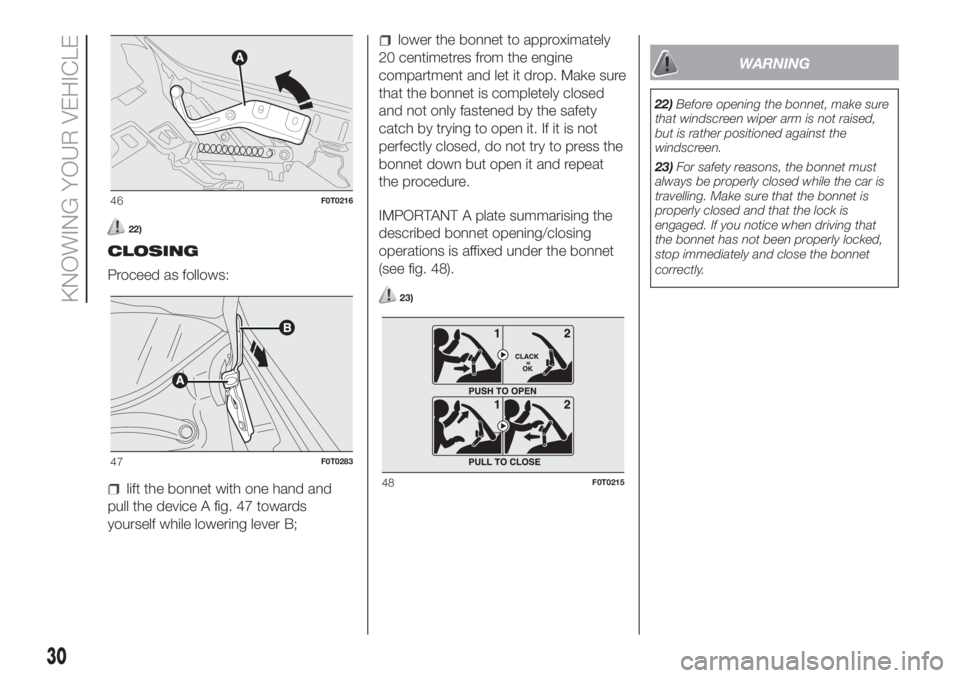
22)
CLOSING
Proceed as follows:
lift the bonnet with one hand and
pull the device A fig. 47 towards
yourself while lowering lever B;
lower the bonnet to approximately
20 centimetres from the engine
compartment and let it drop. Make sure
that the bonnet is completely closed
and not only fastened by the safety
catch by trying to open it. If it is not
perfectly closed, do not try to press the
bonnet down but open it and repeat
the procedure.
IMPORTANT A plate summarising the
described bonnet opening/closing
operations is affixed under the bonnet
(see fig. 48).
23)
WARNING
22)Before opening the bonnet, make sure
that windscreen wiper arm is not raised,
but is rather positioned against the
windscreen.
23)For safety reasons, the bonnet must
always be properly closed while the car is
travelling. Make sure that the bonnet is
properly closed and that the lock is
engaged. If you notice when driving that
the bonnet has not been properly locked,
stop immediately and close the bonnet
correctly.
46F0T0216
47F0T0283
48F0T0215
30
KNOWING YOUR VEHICLE
Page 33 of 220
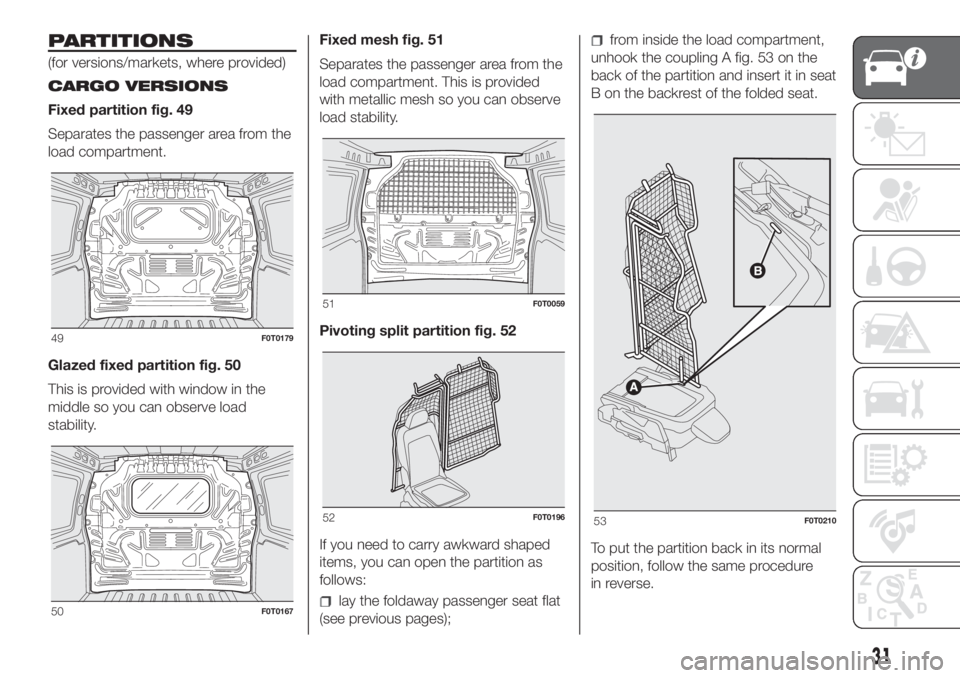
PARTITIONS
(for versions/markets, where provided)
CARGO VERSIONS
Fixed partition fig. 49
Separates the passenger area from the
load compartment.
Glazed fixed partition fig. 50
This is provided with window in the
middle so you can observe load
stability.Fixed mesh fig. 51
Separates the passenger area from the
load compartment. This is provided
with metallic mesh so you can observe
load stability.
Pivoting split partition fig. 52
If you need to carry awkward shaped
items, you can open the partition as
follows:
lay the foldaway passenger seat flat
(see previous pages);
from inside the load compartment,
unhook the coupling A fig. 53 on the
back of the partition and insert it in seat
B on the backrest of the folded seat.
To put the partition back in its normal
position, follow the same procedure
in reverse.
49F0T0179
50F0T0167
51F0T0059
52F0T019653F0T0210
31
Page 34 of 220
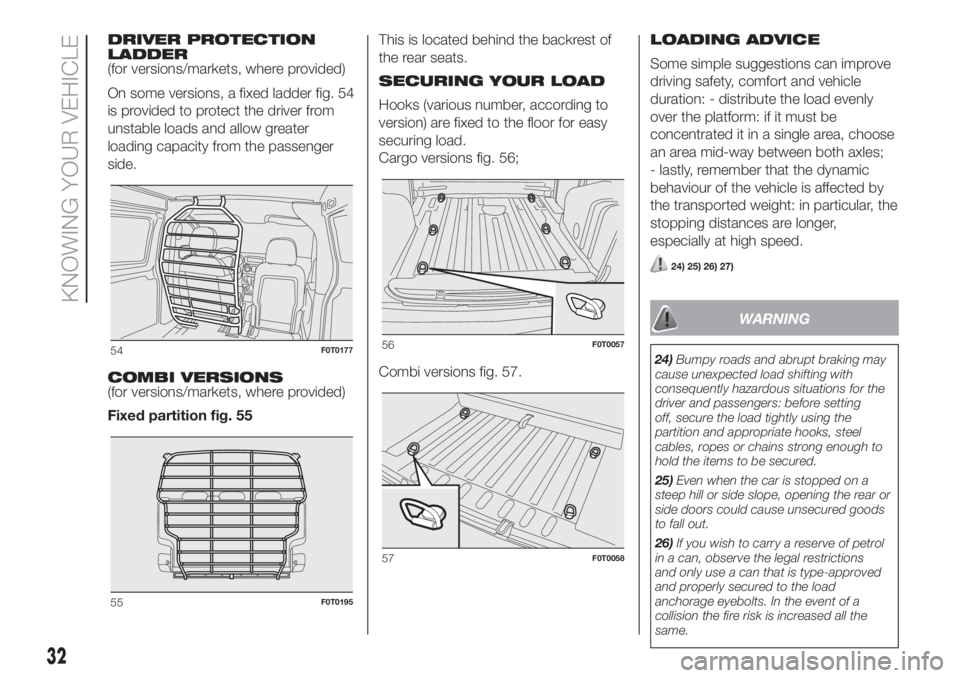
DRIVER PROTECTION
LADDER
(for versions/markets, where provided)
On some versions, a fixed ladder fig. 54
is provided to protect the driver from
unstable loads and allow greater
loading capacity from the passenger
side.
COMBI VERSIONS
(for versions/markets, where provided)
Fixed partition fig. 55This is located behind the backrest of
the rear seats.
SECURING YOUR LOAD
Hooks (various number, according to
version) are fixed to the floor for easy
securing load.
Cargo versions fig. 56;
Combi versions fig. 57.LOADING ADVICE
Some simple suggestions can improve
driving safety, comfort and vehicle
duration: - distribute the load evenly
over the platform: if it must be
concentrated it in a single area, choose
an area mid-way between both axles;
- lastly, remember that the dynamic
behaviour of the vehicle is affected by
the transported weight: in particular, the
stopping distances are longer,
especially at high speed.
24) 25) 26) 27)
WARNING
24)Bumpy roads and abrupt braking may
cause unexpected load shifting with
consequently hazardous situations for the
driver and passengers: before setting
off, secure the load tightly using the
partition and appropriate hooks, steel
cables, ropes or chains strong enough to
hold the items to be secured.
25)Even when the car is stopped on a
steep hill or side slope, opening the rear or
side doors could cause unsecured goods
to fall out.
26)If you wish to carry a reserve of petrol
in a can, observe the legal restrictions
and only use a can that is type-approved
and properly secured to the load
anchorage eyebolts. In the event of a
collision the fire risk is increased all the
same.54F0T0177
55F0T0195
56F0T0057
57F0T0058
32
KNOWING YOUR VEHICLE
Page 35 of 220
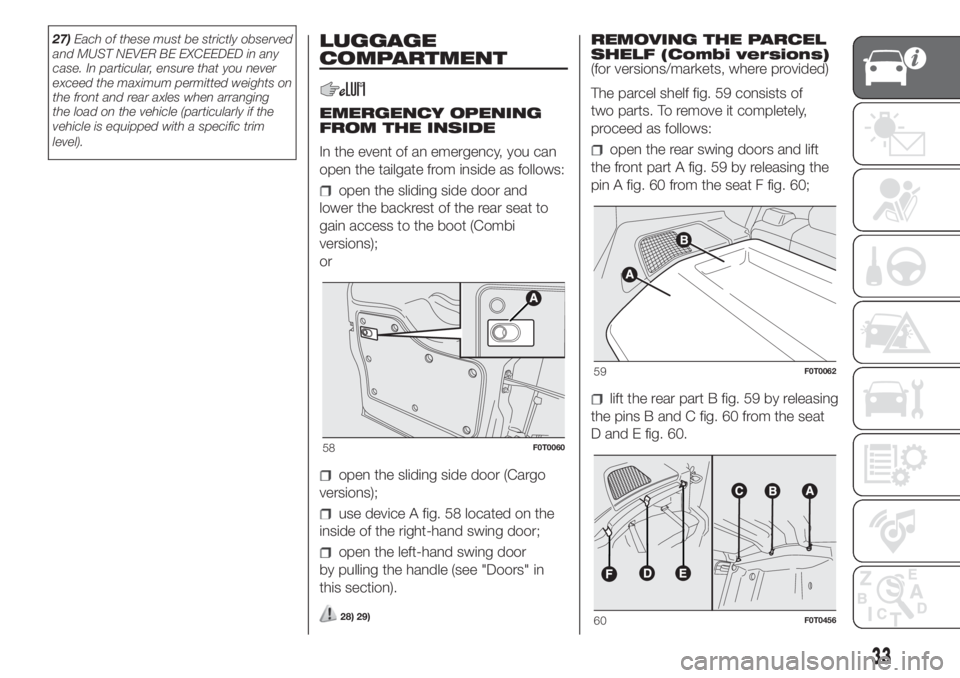
27)Each of these must be strictly observed
and MUST NEVER BE EXCEEDED in any
case. In particular, ensure that you never
exceed the maximum permitted weights on
the front and rear axles when arranging
the load on the vehicle (particularly if the
vehicle is equipped with a specific trim
level).LUGGAGE
COMPARTMENT
EMERGENCY OPENING
FROM THE INSIDE
In the event of an emergency, you can
open the tailgate from inside as follows:
open the sliding side door and
lower the backrest of the rear seat to
gain access to the boot (Combi
versions);
or
open the sliding side door (Cargo
versions);
use device A fig. 58 located on the
inside of the right-hand swing door;
open the left-hand swing door
by pulling the handle (see "Doors" in
this section).
28) 29)
REMOVING THE PARCEL
SHELF (Combi versions)
(for versions/markets, where provided)
The parcel shelf fig. 59 consists of
two parts. To remove it completely,
proceed as follows:
open the rear swing doors and lift
the front part A fig. 59 by releasing the
pin A fig. 60 from the seat F fig. 60;
lift the rear part B fig. 59 by releasing
the pins B and C fig. 60 from the seat
D and E fig. 60.
58F0T0060
59F0T0062
60F0T0456
33
Page 36 of 220
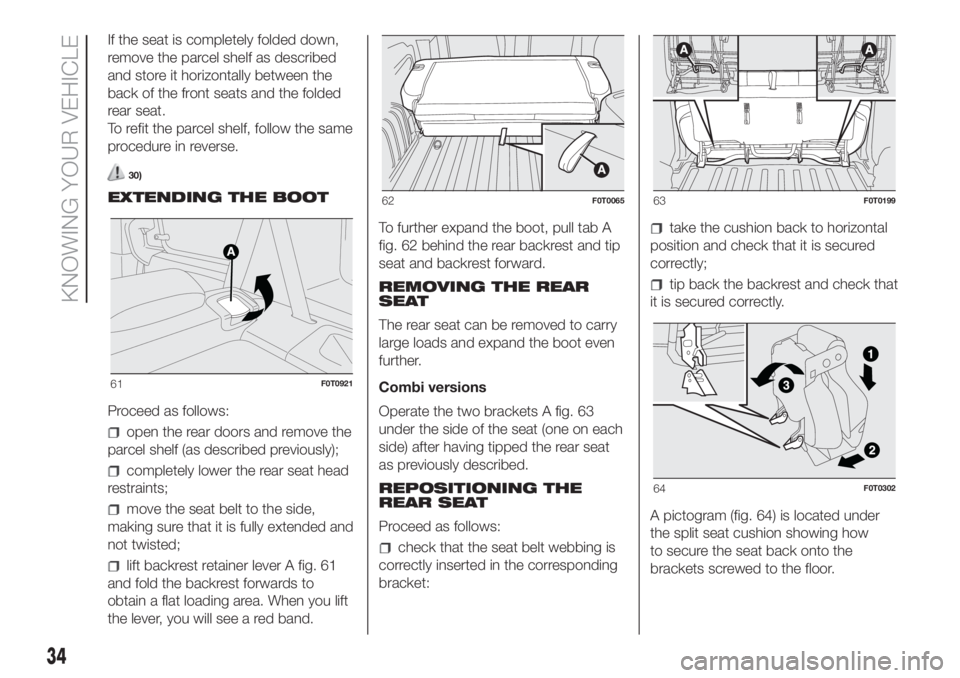
If the seat is completely folded down,
remove the parcel shelf as described
and store it horizontally between the
back of the front seats and the folded
rear seat.
To refit the parcel shelf, follow the same
procedure in reverse.
30)
EXTENDING THE BOOT
Proceed as follows:
open the rear doors and remove the
parcel shelf (as described previously);
completely lower the rear seat head
restraints;
move the seat belt to the side,
making sure that it is fully extended and
not twisted;
lift backrest retainer lever A fig. 61
and fold the backrest forwards to
obtain a flat loading area. When you lift
the lever, you will see a red band.To further expand the boot, pull tab A
fig. 62 behind the rear backrest and tip
seat and backrest forward.
REMOVING THE REAR
SEAT
The rear seat can be removed to carry
large loads and expand the boot even
further.
Combi versions
Operate the two brackets A fig. 63
under the side of the seat (one on each
side) after having tipped the rear seat
as previously described.
REPOSITIONING THE
REAR SEAT
Proceed as follows:
check that the seat belt webbing is
correctly inserted in the corresponding
bracket:
take the cushion back to horizontal
position and check that it is secured
correctly;
tip back the backrest and check that
it is secured correctly.
A pictogram (fig. 64) is located under
the split seat cushion showing how
to secure the seat back onto the
brackets screwed to the floor.
61F0T0921
62F0T006563F0T0199
64F0T0302
34
KNOWING YOUR VEHICLE
Page 37 of 220
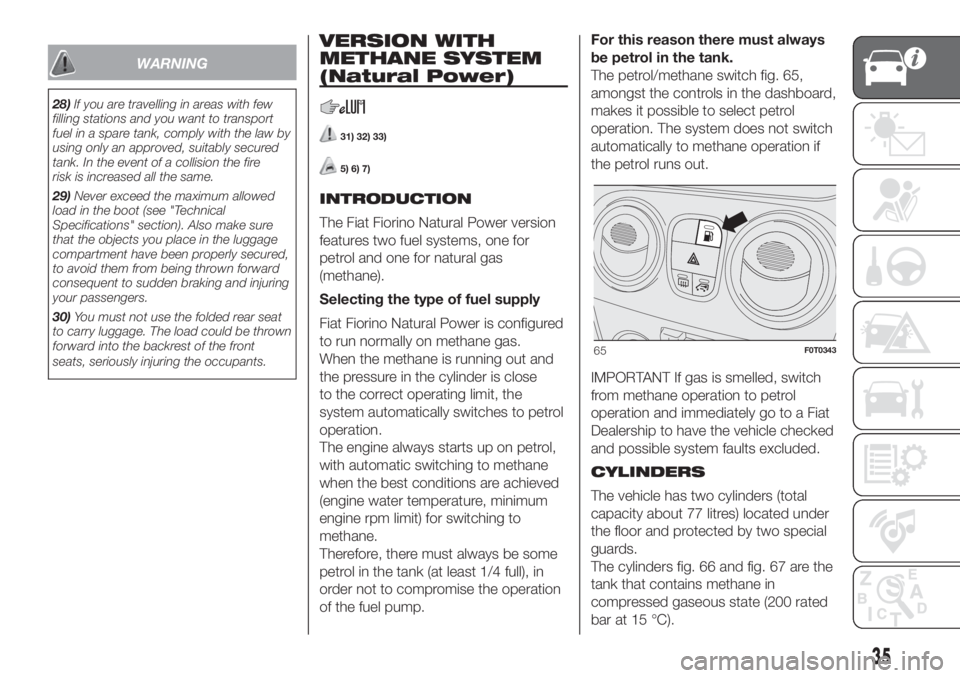
WARNING
28)If you are travelling in areas with few
filling stations and you want to transport
fuel in a spare tank, comply with the law by
using only an approved, suitably secured
tank. In the event of a collision the fire
risk is increased all the same.
29)Never exceed the maximum allowed
load in the boot (see "Technical
Specifications" section). Also make sure
that the objects you place in the luggage
compartment have been properly secured,
to avoid them from being thrown forward
consequent to sudden braking and injuring
your passengers.
30)You must not use the folded rear seat
to carry luggage. The load could be thrown
forward into the backrest of the front
seats, seriously injuring the occupants.
VERSION WITH
METHANE SYSTEM
(Natural Power)
31) 32) 33)
5) 6) 7)
INTRODUCTION
The Fiat Fiorino Natural Power version
features two fuel systems, one for
petrol and one for natural gas
(methane).
Selecting the type of fuel supply
Fiat Fiorino Natural Power is configured
to run normally on methane gas.
When the methane is running out and
the pressure in the cylinder is close
to the correct operating limit, the
system automatically switches to petrol
operation.
The engine always starts up on petrol,
with automatic switching to methane
when the best conditions are achieved
(engine water temperature, minimum
engine rpm limit) for switching to
methane.
Therefore, there must always be some
petrol in the tank (at least 1/4 full), in
order not to compromise the operation
of the fuel pump.For this reason there must always
be petrol in the tank.
The petrol/methane switch fig. 65,
amongst the controls in the dashboard,
makes it possible to select petrol
operation. The system does not switch
automatically to methane operation if
the petrol runs out.
IMPORTANT If gas is smelled, switch
from methane operation to petrol
operation and immediately go to a Fiat
Dealership to have the vehicle checked
and possible system faults excluded.
CYLINDERS
The vehicle has two cylinders (total
capacity about 77 litres) located under
the floor and protected by two special
guards.
The cylinders fig. 66 and fig. 67 are the
tank that contains methane in
compressed gaseous state (200 rated
bar at 15 °C).
65F0T0343
35
Page 38 of 220
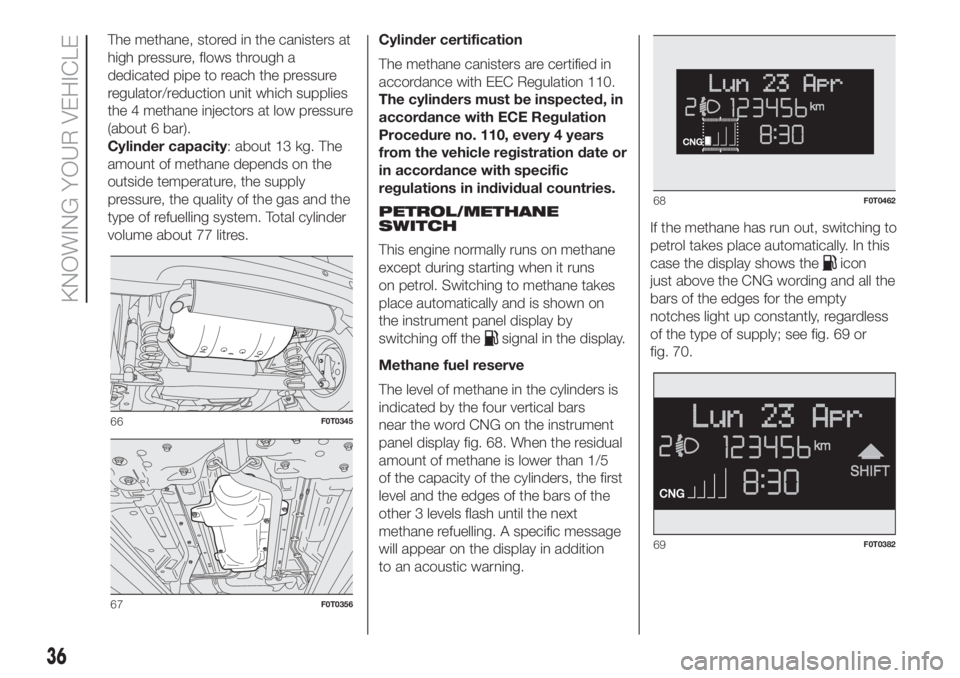
The methane, stored in the canisters at
high pressure, flows through a
dedicated pipe to reach the pressure
regulator/reduction unit which supplies
the 4 methane injectors at low pressure
(about 6 bar).
Cylinder capacity: about 13 kg. The
amount of methane depends on the
outside temperature, the supply
pressure, the quality of the gas and the
type of refuelling system. Total cylinder
volume about 77 litres.Cylinder certification
The methane canisters are certified in
accordance with EEC Regulation 110.
The cylinders must be inspected, in
accordance with ECE Regulation
Procedure no. 110, every 4 years
from the vehicle registration date or
in accordance with specific
regulations in individual countries.
PETROL/METHANE
SWITCH
This engine normally runs on methane
except during starting when it runs
on petrol. Switching to methane takes
place automatically and is shown on
the instrument panel display by
switching off the
signal in the display.
Methane fuel reserve
The level of methane in the cylinders is
indicated by the four vertical bars
near the word CNG on the instrument
panel display fig. 68. When the residual
amount of methane is lower than 1/5
of the capacity of the cylinders, the first
level and the edges of the bars of the
other 3 levels flash until the next
methane refuelling. A specific message
will appear on the display in addition
to an acoustic warning.If the methane has run out, switching to
petrol takes place automatically. In this
case the display shows the
icon
just above the CNG wording and all the
bars of the edges for the empty
notches light up constantly, regardless
of the type of supply; see fig. 69 or
fig. 70.
66F0T0345
67F0T0356
68F0T0462
69F0T0382
36
KNOWING YOUR VEHICLE
Page 39 of 220

If you want the car to run on petrol,
press the button fig. 71 located
between the controls in the dashboard.
The LED on the button switching on
indicates that the request for switching
has taken place correctly.The actual change to the chosen fuel
system takes place depending on
the vehicle usage conditions to
guarantee switching in absolute safety
and will be confirmed by the
warning
light in the instrument panel display
coming on/going off.
Manual switching of the operating
mode from petrol to methane and
vice versa only occurs if the engine
speed is below 2000 rpm.
In addition, in the case of starting at
outside temperatures of below around
-10°C, the switching times from Petrol
to Methane increase to allow the
pressure regulator/reduction unit to
become warm enough.
IMPORTANT If switching takes place
during acceleration or pick-up, there
may be a brief flat spot (drop in power).
WARNING
31)The Fiat Fiorino Natural Power is
equipped with a high pressure methane
fuel supply system, designed to operate at
a rated pressure of 200 bar. It is dangerous
to stretch the system with higher
pressures. To prevent damage to the
methane system parts when towing or
lifting the vehicle, follow the instructions in
the main handbook in the chapter: "Towing
the vehicle". If there is a problem with the
methane system, only contact a Fiat
Dealership. Do not alter the methane
system configuration or components. They
are designed exclusively for the Fiat
Fiorino Natural Power. The use of other
components or materials could cause
malfunctions and prejudice safety.
32)When oven painting, the cylinders must
be removed from the vehicle and refitted
by a Fiat Dealership. Although the methane
system has numerous safety features, it is
advisable to close the manual tap on the
cylinders every time the vehicle is not
in use for a long period, transported on
other vehicles or moved in an emergency
as a result of a breakdown or accident.
33)If gas is smelt, switch from methane
operation to petrol operation and
immediately go to a Fiat Dealerships to
have the vehicle checked and possible
system faults supply excluded.
70F0T0383
71F0T0343
37
Page 40 of 220
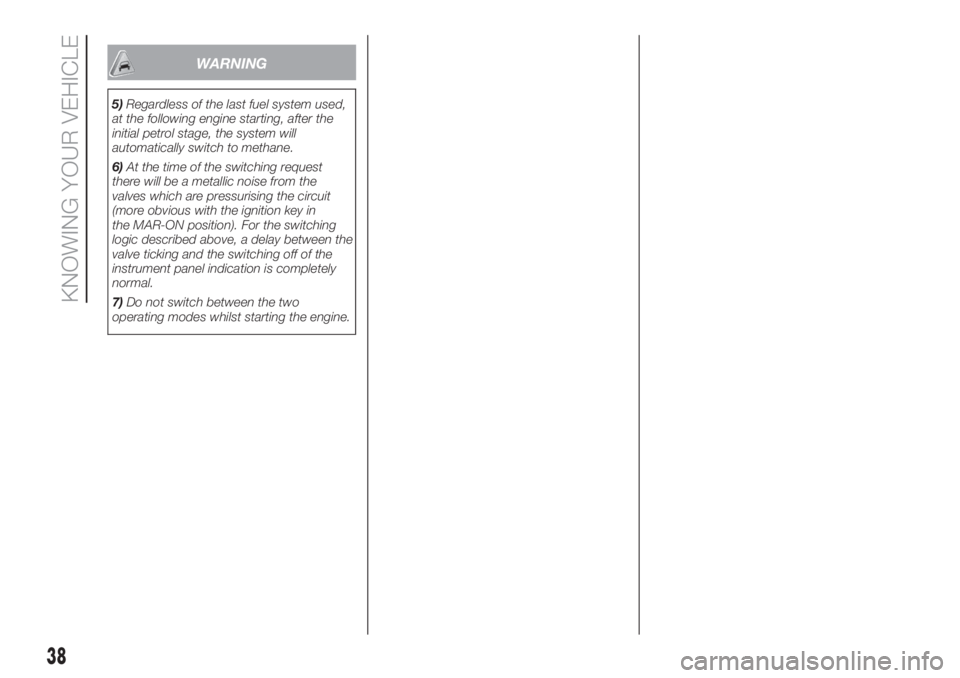
WARNING
5)Regardless of the last fuel system used,
at the following engine starting, after the
initial petrol stage, the system will
automatically switch to methane.
6)At the time of the switching request
there will be a metallic noise from the
valves which are pressurising the circuit
(more obvious with the ignition key in
the MAR-ON position). For the switching
logic described above, a delay between the
valve ticking and the switching off of the
instrument panel indication is completely
normal.
7)Do not switch between the two
operating modes whilst starting the engine.
38
KNOWING YOUR VEHICLE